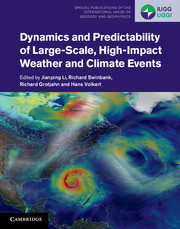Book contents
- Dynamics and Predictability of Large-Scale, High-Impact Weather and Climate Events
- Special publications of the International Union of Geodesy and Geophysics Series
- Dynamics and Predictability of Large-Scale High-Impact Weather and Climate Events
- Copyright page
- Contents
- Preface
- Frontispiece
- Book part
- Contributors
- Part I Diagnostics and prediction of high-impact weather
- Part II High-impact weather in mid latitudes
- Part III Tropical cyclones
- Part IV Heat waves and cold-air outbreaks
- Part V Ocean connections
- Part VI Asian monsoons
- 25 Extreme weather and seasonal events during the Indian summer monsoon and prospects of improvement in their prediction skill under India's Monsoon Mission
- 26 Interannual variability and predictability of summer climate over the Northwest Pacific and East Asia
- 27 Impacts of annular modes on extreme climate events over the East Asian monsoon region
- Index
- References
27 - Impacts of annular modes on extreme climate events over the East Asian monsoon region
from Part VI - Asian monsoons
Published online by Cambridge University Press: 05 March 2016
- Dynamics and Predictability of Large-Scale, High-Impact Weather and Climate Events
- Special publications of the International Union of Geodesy and Geophysics Series
- Dynamics and Predictability of Large-Scale High-Impact Weather and Climate Events
- Copyright page
- Contents
- Preface
- Frontispiece
- Book part
- Contributors
- Part I Diagnostics and prediction of high-impact weather
- Part II High-impact weather in mid latitudes
- Part III Tropical cyclones
- Part IV Heat waves and cold-air outbreaks
- Part V Ocean connections
- Part VI Asian monsoons
- 25 Extreme weather and seasonal events during the Indian summer monsoon and prospects of improvement in their prediction skill under India's Monsoon Mission
- 26 Interannual variability and predictability of summer climate over the Northwest Pacific and East Asia
- 27 Impacts of annular modes on extreme climate events over the East Asian monsoon region
- Index
- References
- Type
- Chapter
- Information
- Publisher: Cambridge University PressPrint publication year: 2016
References
- 11
- Cited by



